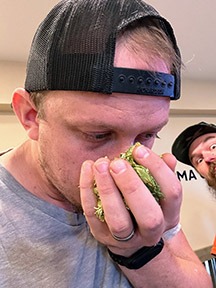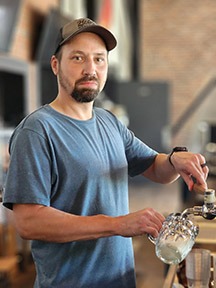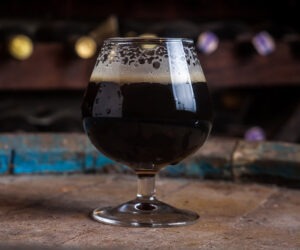Maximizing Tropical Flavors & Aromas: Tips from the Pros
Whether it’s through hops, fruit, or thiol-enhancing products, brewers have many ways to boost sought-after tropical aromas and flavors. Here is what three pros who make killer hazy IPAs and fruited sours do to make you feel like you’re drinking in paradise.

Ben Haugen is the Head Production Brewer at Lupulin Brewing Company in Big Lake, Minnesota
We change up hop varieties when brewing tropical IPAs all the time. The book says Citra®, but we have had good success with El Dorado® and Nectaron® more recently. It really depends on which fruit flavors you are looking for. Pineapple and mango? Citra® and Sultana® are really nice. Melon and coconut? El Dorado® and Sabro®. We use six different varieties in our flagship hazy IPA, Hooey. That said, don’t blindly toss in hops of a certain variety; you’ve got to smell the hops themselves because even within varieties there can be massive differences in profiles. I would recommend finding your favorite brewery that has your favorite profiles and reach out and see if they would be willing to let you smell around! A lot of brewers in the industry are super cool and tons of them would be delighted to communicate with you about what they have and what they are jamming on right now.
Once you choose your hops, it’s all about how you use them. We tend towards whirlpool hopping and aggressive dry hops to punch up those flavors. We have messed around with dip hopping and zero IBU IPAs, but what we have found to be pretty consistent in our tasting panels is the desire for some mid- and late-additions in the kettle. A lot of hazy IPAs can be overly sweet and full bodied, but with a little balancing bitterness, they can be much more enjoyable. However, be mindful of the myrcene percentages of the hops you are adding to the hot side. If you are really shooting for a super soft and juicy IPA, adding too much myrcene on the hot side can result in some really intense woodiness and astringency.
Thiolized yeast is another way to boost tropical aromatics. With these we have experienced aromas that range from passion fruit to mango. Omega’s Helio Gazer is a strong contender for some of our core beers going forward. It is super easy to use and has some really nice haze and body contributions. We ferment it around 65 °F (18 °C) just to moderate it a little more, but if you don’t have climate control, start it a little cooler and just let it free rise. Be forewarned with using thiolized yeast; however, as sulfur that is released in these ferments can have some very intense and odd aromas, like celery and swamp water. This should clear up in a couple days and will not be present in your final product.
Omega is trialing a kveik strain that we have been able to get our hands on, and it has been incredible. It would be a great option for homebrewers if you find it. I would recommend starting it a little cooler, like 75 °F (24 °C), before you let it free rise, and try to get it down to 60 °F (16 °C) before dry hopping to maintain the aromas a little better.
If you have the time and patience, or the bankroll to use whole real fruit or purees, there is no substitute for the real deal. I love using real fruit whenever possible, and I am absolutely OK with finding high-quality vendors like Amoretti to subsidize some of the softer flavors or flavors that just don’t hold up in beer. There are some excellent podcasts or presentations out there that talk about some components in fruit that get consumed during fermentation. Part of the fun in brewing is trying all the things and seeing if it makes something that works!
On another note, please do reach out! Brewers love talking about beer! Bring some bottles and an open mind and I guarantee some brewer in your area would love to talk about ideas for your future brews.

Tripp Moser is the Head Brewer at Heist Brewery in Charlotte, North Carolina
When looking for tropical flavors from hops I think El Dorado® and Azacca® are tremendous varieties that lend great tropical notes, and I feel they need more love! Strata® is probably my favorite hop to hit the market in the last few years because the passion fruit character is unparalleled.
Our preferred method for brewing hazy, tropical IPAs usually involves:
1. Whirlpool hopping added under 190 °F (88 °C) at around 1.5 lbs./barrel (0.75 oz./gallon or 5.5 g/L).
2. Post-fermentation dry hopping from 4–10 lbs./barrel (2–5 oz./gallon or 15–37 g/L).
In my experience, to maximize the tropical notes, post-fermentation dry hops will give you a true experience of what those hops can offer at face value. This allows for consistent recipe development and an expected outcome almost every time.
We’ve also experimented a little with thiolized yeast. We used Omega’s Cosmic Punch strain for the first time this year and it was an awesome experience as a brewer. We experimented with four different mash hops and each was a total mind-bender (MotuekaTM, CZ Saaz, HS17701, and Mosaic®). CZ Saaz was our favorite with a very distinct ripe mango flavor.
We’ve also used Phantasm powder. We have a beer called Phantasm of the Opera that we love to brew about once a year. We use Phantasm powder throughout the brewing and fermentation process. New Zealand hops MotuekaTM and RakauTM are used for dry hopping and the end result is an explosion of white wine, peach rings, pineapple, and passion fruit. I’d recommend Phantasm powder additions during late fermentation for its biotransformation properties. Note that it might get messy and sanitation is key.
We do have a handful of hazy/NEIPA beers that we add real fruit to because we believe it contributes to a delicious, cold, tasty snack. But there are so many hops that impart those tropical flavors that almost all our recipe development is driven around the hops. It really comes down to the situation and what we want the customer to experience.

Alex Dee is a Brewer and one of three founders of New Park Brewing in West Hartford, Connecticut
To really maximize the tropical notes in IPAs, choose your hop varieties carefully, keep kettle additions small, whirlpool and dry hop additions very large, and make sure you do everything you can to limit oxygen exposure. Kegging usually works better than bottling for producing the freshest tasting IPAs. We have an “A list” of favorite hops at New Park. Tropical varieties on that list include Citra®, MotuekaTM, Nelson SauvinTM, GalaxyTM, RiwakaTM, and El Dorado®. To maximize the flavors, we utilize additions in the whirlpool of up to 1.2 lbs. per barrel (0.6 oz./gallon or 4.5 g/L). We prefer to add one large dry-hop addition around 4.4 lbs. per barrel (2.3 oz./gallon or 17 g/L) because it gives a nice and clean result, lacking “green” hop bite but still producing a beer that’s full of flavor. Our dry-hop addition is about two weeks after brew day, when gravity has stabilized. We like to let the dry hops sit for four days before cold crashing and transferring to the bright tank, where any green flavors or harshness drops out over the course of two days.
For IPAs or hoppy beers, I personally find bitterness does not play well with the acidity in fresh fruit, so we rely solely on the hops for tropical flavors and aromas. For sours, we love using all kinds of fresh and local fruit, as well as high-quality fruit purees for larger batches of canned beer. One of our barrel-aged saisons combines lots of fresh passion fruit from Hawaii with a very small amount of Citra® as a “dry hop” right before bottling. This works really well because it doesn’t generate too much bitterness — only wonderful tropical flavors that complement the passion fruit and the wild yeast character of the beer.
We haven’t messed around with any of the thiolized yeasts or other thiol-enhancing products out there. Maybe I’m old school, but I just prefer the classic combination of grain, English ale yeast, and very high-quality and fresh T90 hop pellets. That said, I wouldn’t say no to a small test batch using any of these products.



